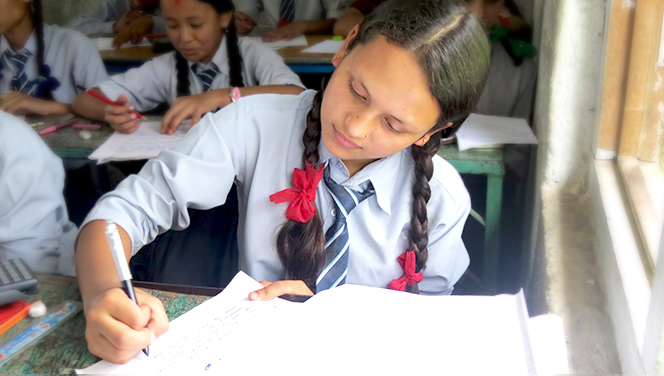What is the present situation?
For the past few weeks, COVID infection is rapidly increasing in Nepal, especially in Kathmandu and other big cities. The first wave of infections peaked in October 2020 and since then it “decreased” dramatically. Starting in February of this year, the government decided to open up the economy and everything was allowed to operate at full capacity, including educational institutions.
As most experts had warned, COVID infections are once again spreading like wildfire all across Nepal. Because of the mutant variants, infection rates is now very high and more young people and children are starting to get sick. Most of the ICU and ventilators allocated for COVID patients are occupied and the supply of oxygen is grossly inadequate.
 (Image courtesy of: Nepali Times, April 22, 2021) – Note the dramatic rise after the lifting of initial lockdowns and coinciding with major festivals of Dashain and Tihar.
(Image courtesy of: Nepali Times, April 22, 2021) – Note the dramatic rise after the lifting of initial lockdowns and coinciding with major festivals of Dashain and Tihar.
What is the government doing now?
To combat the spread of the infection, the government decided to once again close all education institutions from April 17. From April 29, several restrictive measures, such as restriction in vehicular movement and closure of non-essential business have been announced by the government.
What are the causes behind the second wave?
First of all, the government decided to reduce the number of PCR tests conducted from the October peak. In reality, the cases were not decreasing, only the number of positive PCR tests decreased, which is logical since the tests were reduced. This manipulation of data gave the government an opportunity to open the economy at the full scale. The need to keep the economy going is completely understandable, but given what we have already seen in terms of number of COVID-related deaths, this was a very risky and dangerous policy. For the public the “decrease” in infections unfortunately gave the impression that it was ok to not follow the safety measures, like wearing face masks, using sanitizer and maintaining physical distance. The failed government policies and the resulting public behavior are to be blamed for the second wave whose impact may not be felt fully for a few more weeks.
What happens now?
All “non-essential services” will be shut down for a week. However, the definition of what is essential and what is non-essential is up for debate, and such a vague policy will not be enough to stop the spread. For example, a wedding ceremony could be allowed if one can get an approval from the local government. This opens up the potential for mass confusion, which ultimately means that the infection rate will not decrease if such events continue to occur. All educational institutions are closed until further notice. This was absolutely the right policy however, this also means that only the students from affluent families will have access to online education, and this surely will further widen the gap in access to education during the shutdown. This is one of the major reasons why our team is building up our own Digital Literacy and is working on providing more access to technology and computer-based education to our girls and the community at large.
Where are the vaccines?
To date, Nepal has received 1.8 million doses of Covid vaccines which were donated by India and China. This means even if implemented very efficiently, only roughly 17 percent of the total population 18 years and above (Government has no plan to vaccinate the population 17 and under) will be inoculated. This is nowhere close to what is needed in order to reach collective immunity. The government has procured 2 million additional doses of AstraZeneca vaccines from India, however there is no official word when Nepal can actually receive those vaccines.
What can we do?
Since it could take years to vaccinate the majority of the population in order to reach “herd immunity”, the government needs to formulate and implement preventive policies to combat the spread of this deadly virus. The general public needs to obey the preventive measures and safety measures, but in order to do so, they need to believe that the measures are valid and effective. If we collectively fail to define sound policies, communicate them broadly, and to educate the public on their importance, then Nepal will experience not only more waves of COVID, but a tsunami in the near future.
- Aftermath of 2023 Earthquake and Lending a Helping Hand - November 23, 2023
- Sowing the Seeds of Empowerment through Sewing - July 30, 2023
- Vaccinating students from COVID is the boost we need in Nepal - January 30, 2022
- Re-opening Act: To be or not to be in school in person - September 29, 2021
- A Gasp of Hope in the Fight Against COVID-19 - August 31, 2021

